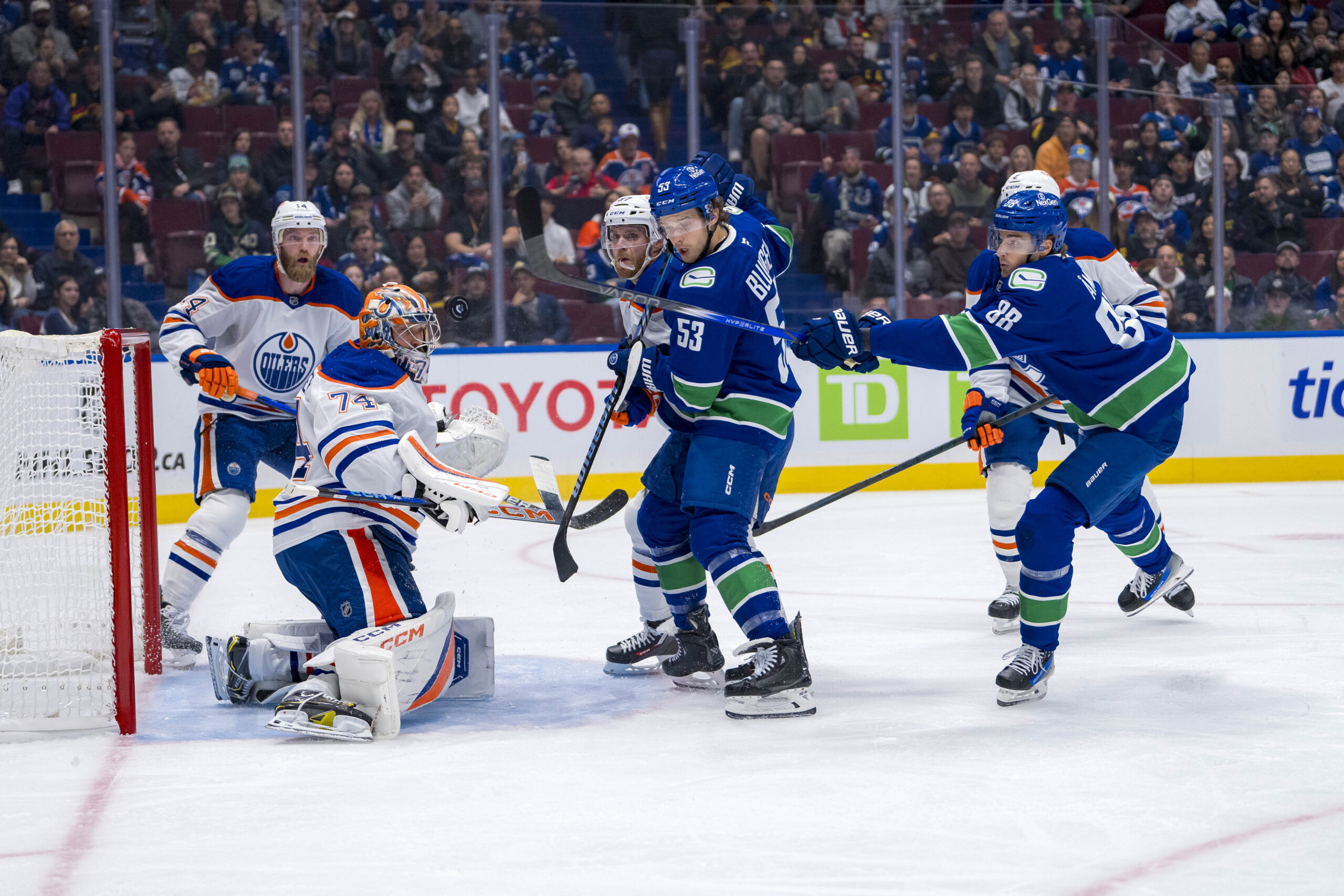Stop us if you’ve heard this before, but the Vancouver Canucks third line is coming through for them. They’re doing so well, in fact, that we’re taking a closer look at how they stand up to last year’s version.
Canucks Third Line Challenge
There have been changes in Vancouver since last season ended. Players walked, others signed, some waited. Eight players who weren’t in the Canucks system are regulars now. Include Arshdeep Bains, who’s played as many games as Daniel Sprong and one more than Derek Forbort, and that’s nine. It’s not an unreasonable amount of turnover, but the surprising thing is how spread throughout the team they are. At the start of the season, every line had a new face, if Aatu Räty counts.
Dakota Joshua sitting out with injury kept last season’s “THE Line” from starting the year, otherwise it may have been the exception. There is some question about where Joshua fits when he returns. We expect a fourth-line start, at least for a few games, until he gets his skates under him. But when he’s back up to full speed, he’ll join… who? It doesn’t look like there’s any space in his old home.
Now and Then
The current Canucks third line still has Teddy Blueger centring it. He’s still a bit overqualified for the spot, but better to have too much talent for the role, than too little. The current configuration that’s running so well sees him flanked by Kiefer Sherwood and Danton Heinen.
All three players see short-handed time, though only Heinen has any on the power play. Even with that, all three are below 14 minutes of ice time per game. They’ve produced well despite those limits. Heinen is at two goals and four points, while the others are at three goals and five points. As fun as it is to play with small sample sizes, they probably won’t finish the season at 50+ points each. Especially not if they remain together as a line, and that line stays below 14 minutes on average.
By comparison, last season saw Conor Garland and Dakota Joshua on Blueger’s wings. Garland was a power play regular, while the other two got extra time shorthanded. All three finished averaging between 14 and 15 minutes of ice time per night. Garland did finish the season at 47 points, which is great for the third line. Joshua and Blueger ended the year at 32 and 28 respectively, which was also perfectly decent. Garland’s moved up the lineup and Joshua will likely follow suit.
Canucks Third Line Compare and Contrast Starting With the Perfect Past
Last year’s trio worked extremely well together as a unit by happy accident as much as anything. In camp, Garland and Joshua were thought of as fighting with each other for a possible top-six spot. The other would have scraps lower on the team.
Joshua was well known for his physicality, but that hid surprisingly good hands in tight. Garland had been searching for someone who complemented his style of one-man keep-away in the offensive zone. Blueger controls the puck well and gets it where it’s needed, and safely.
According to Hockey Reference, all three finished on the positive side for takeaways, finishing with 107 to just 48 giveaways. That’s a pretty positive indicator of their checking ability, and it’s confirmed by their Corsi. The Canucks had 54.6% of the shots with that line on the ice.
The Current Crew
It’s early enough in the season to get silly numbers, but the current threesome has had six takeaways to 13 giveaways so far. But as a line, their Corsi is even better at 56.7% of the shots were by Vancouver. However, keep in mind, we’re comparing 43 games by a line last season to a line that’s played four this one. Add to that the change in philosophy that head coach Rick Tocchet has applied and you have a difficult comparison. And one that frankly isn’t all that valid.
Stylistically, though, there are interesting differences. Blueger is obviously the same player. His heads-up approach to the game makes him not just a smart passer but a defensive conscience. His ability to find players and get them the puck at the right moment makes the line work.
The old strategy of “enter the zone, give it to Garland, and let other people try to get it off him” is no longer available. As effective as it was last year, this season’s strategy means shots on the attack before the defence sets up. While none of them have Joshua’s mass, the chances they get aren’t reliant on crashing the net and standing for a deflection. Heinen is one of those “mystery players” who can glide into empty spaces. And once he’s in place, he can guide the puck in.
Sherwood, on the other hand, is an absolute wrecking ball. So far, Sherwood is averaging a terrific seven hits per game right now. Seven! That total amount leads the league by seven, and everyone else in the top 30 has played more games. You can imagine how he gets his points. Hint, not by controlling the puck, but by controlling opposing defences.
Who’s Better/Who’s Best?
With less than ten percent of the season gone by, we can’t say much more than that these guys are fun to watch. They’ve gotten results in Tocchet’s new system, and that’s what counts. Joshua’s return is imminent, and in another week the coaching staff will need to make decisions. But for now, it’s good enough to respect the past and enjoy the present. Especially when that present is driving the opposing team nuts.
Main Photo Credit: Bob Frid – USA TODAY Sports






